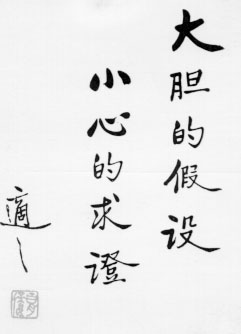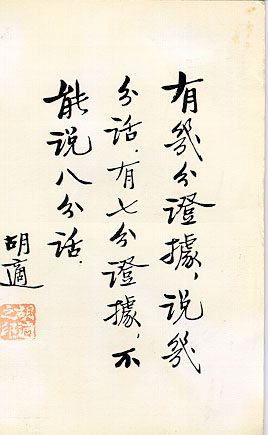 |
 |
| 大膽的假設,
小心的
求證。 Courageously set forth hypotheses Cautiously seek for proof |
有幾分證據,
說幾分
話;有七分證據,不能說八分
話。 Having X parts proof, speak X parts talk; Having 7 parts proof, can't speak 8 parts talk |
名不正,則言不順;言不順,則事不成
If names be not correct, language is not in accordance with the truth of things. If language be not in accordance with the truth of things, affairs cannot be carried on to succcess. (Analects, XIII.3.5; James Legge, trans.)Topics:
Papers will be graded according to the following criteria (in order of importance):
(1) Clarity of thesis statement and success of its defense, in terms of both evidence and logic(2) Thoroughness and accuracy of annotation
(3) Appropriateness of forms for notes and bibliography
(4) Grammar, syntax, and diction
(5) Spelling and overall presentation
(1) You want to get as close to
primary sources as you can. If you
do
not read the language of the area you are working on, then aim for
translations
of primary sources. If these are not available, then look for
monographs
where the notes and bibliography indicate that the author has used
primary
sources. Remember that books from academic presses can usually be
considered
more reliable, since they undergo a peer review process more rigorous
than
that of commercial presses. "Vanity presses" print books at the
author's expense and so should be treated with great caution.
Sources from the Internet should be assumed to fall under the "vanity
press" rubric until proven otherwise; for guidance on sifting through
Internet sites, check the Library's guide to Evaluating
Internet Sources.
In general, tertiary sources like texts, encyclopedias, or handbooks should be used only for initial inspiration or, if you are writing an historiographical paper, as primary evidence of the existence of a standard interpretation.
(2) Citations from works not in English should be presented in the original language, with a translation provided (for longer quotations, put the original into a note).
(3) In setting a focus for
a paper, there's a tendency to think in
terms
of a canvas waiting to be filled up with paint, or of a narrative
distance
to be covered by running from a starting point to a finish line.
Instead,
it may be more useful to think of your thesis as the spot where you've
stopped dribbling in a basketball game [a sport that used to have
serious
significance here at Georgetown...]; the whole court is still relevant
to your game, and you can feint or pass in any direction, but you have
to keep yourself rooted to that analytical pivot. Keep asking yourself:
what's the one main point to be made, and how does this information
support
that effort?
Some guidelines on format:
(1) The text of your paper should be short and concise:
in undergraduate courses, 5-7 pp. for undergraduates; 12-15 pp. for graduate students.in graduate-level courses, 20-25 pp. for everyone
(2) Sources should be indicated by either endnotes or footnotes,
sequentially numbered throughout your text. Do not use
"internal
notes" ("parenthetical references"), where the citation appears as part
of your text itself. Note
numbers
in the text should be in superscript. A competent word-processing
program
will handle both the superscripting function and the automatic
(re)numbering
of notes.
(3) In dealing with another author's work:
(a) Whenever possible, provide references to the original source of works cited (e.g., Secondary Author, Book that I Read, citing Original Author, Original Source). In this regard, collections of excerpted readings might be useful in introducing you to sources, but make every effort to get back to the original, fuller texts. And, when you do, then your note's format can read: Author, Original Work, as cited/quoted in...(b) Notes and bibliography should follow the forms given in Turabian, ch. 7. For an on-line version of this guide, check out: http://www.library.georgetown.edu/guides/turabianfoot/.
i. In your notes, the first reference to a work should give a full citation(c) In citing classics like Confucius or Mencius, it's customary to give the original chapter and verse (since there are so many different translations available), in addition to the page number in the particular edition that you are citing.
ii. For subsequent references to a work already cited, use a "short-name" format . Turabian's "Method B") is a good example. The old forms of op. cit. or ibid. are still correct but are not preferred (since there's great potential for confusion when cutting/pasting).
(d) In editing quoted materials, be sure to indicate deleted words through ellipses (i.e., "...") and interpolated words through the use of brackets "[ ]", not parentheses "( )".(e) Every work cited in your paper should also be listed in the bibliography, and each bibliographic entry should include either the book's Library of Congress call number (i.e., the number by which you find the book on Lauinger's shelves) or a note that it is your personal copy.
(4) Preparation of the final copy:
(a) keep a copy for yourself (whether it's a hardcopy or on a disk, you want to be able to reproduce your final version whenever needed).(b) Use standard margins and fonts, and double-space the entire text, except for block quotations.
(c) Number your pages, in the upper-right corner.
(5) Handing in your final copy:
(a) Don't bother with fancy covers or folders; just put a title page on top and staple/clip it all together.(b) Your completed paper should contain the following elements:
i. a title page:
a) which includes your name, the date, and course name; click here for a template;
b) clever/cutesy titles are acceptable, but you should also provide a sub-title which indicates what the paper is actually about;
c) title-pages do not carry a page number; pagination begins with the first page of your text;
ii. the body of your paper, double-spaced, with page-numbers indicated;
iii. endnotes (unless you prefer to use footnotes); and
iv. bibliography: alphabetized by author and in "hanging-indent" format
(c) Attach all copies of your prospectus and topic statement, plus the comments which you got back, to the bottom of your final copy.(d) All papers should also be submitted in electronic format via Blackboard's "Assignments" page. This does not, however, take the place of submitting a hardcopy as well. Check out the revelant section in the Class Protocols.
It would be helpful if you think of footnotes and bibliographic references as the tools by which historical writing can most closely approximate the "reproducibility" requirement of scientific experimentation. Your notes are the means by which your reader can, in essence, "reproduce" your research, checking your interpretations and conclusions against the original sources. For this reason, thoroughness and accuracy are crucial.
Your notes are also the best means of acknowledging your intellectual debts and your dependence upon the larger community of scholarship. For this reason, adherence to the accepted conventions of the field regarding annotation is taken as a mark of intellectual honesty, as well as of professional courtesy.
Given these considerations, take seriously the following guidelines:
Some other points of style which you should consider include:
(1) Note all sources (this is not merely a question of style, but an essential part of scholarship, mentioned here to emphasize the point yet one more time...)
(2) Be very sparing in your use of direct quotations, and don't use them at all merely to advance your narrative; if you do quote, then:
(a) focus on the telling detail or on a particularly apt description, not on the author's general conclusions; and(3) Aim for the most unambiguous presentation possible. It is not enough that your words mean what you want them to mean; you should also make sure that they cannot be misinterpreted to mean something else.(b) use the block form (indented and single-spaced) where appropriate (for direct quotations over three lines).
(4) Use the "historical past" tense; present-tense verbs do convey drama and immediacy, but are not appropriate for scholarly writing.
(5) When presented with a choice between verbs and nouns, choose verbs.
(6) Avoid passive verb constructions; make clear who or what is responsible for the action in each sentence.
(7) Try to maintain a single focus for each paragraph, identified by a topic sentence.
(8) In dealing with names
and terms from languages which do not use
the Latin alphabet, use whatever standard system of transliteration you
prefer, so long as you use it consistently (and correctly) throughout
the
paper. Remember to underline all foreign words, especially at
their
first appearance, and provide a brief translation.
Use of word-processors in
writing papers:
The opportunities which the use of a word-processing program gives you for making quick revisions, keeping track of notes and bibliography, etc., make this a crucial skill for success in today's world. However, be aware that the use of this marvel of technology is a mixed blessing, so keep the following warnings and guidelines in mind:
(1) Unless your program is equipped with a proportional font, switch off the "right justification command;" otherwise you'll end up with a "Swiss Cheese" effect as the program inserts huge spaces between words to push a line out to the right margin.
(2) Back-up your files the same way you would keep a photocopy of anything you turned in. Do not delete your file until after you have gotten your paper back.
(3) Your program should be able to insert page numbers automatically (preferably, in the upper-right corner)..
(4) Speller programs are deceitfully reassuring, since they will not catch a word that is properly spelled but improperly used (click here for an example...). There's no substitute for old-fashioned proof-reading to catch errors in syntax or vocabulary.
(5) For notes, use a program like WordPerfect which can insert the notes automatically. If your program requires you to do the notes manually, at least make sure that it lets you insert the note numbers as superscripts; other formats are not acceptable. I have no preference between footnotes and endnotes, but just make sure your notes are numbered sequentially (rather than starting with #1 on each page) throughout your paper.
(6) A computer's increased facility also brings a vulnerable dependency and the potential for disaster on a truly horrendous scale. Excuses like "I couldn't find a free terminal," "the printer was down," "my disk got scratched," or "the machine crashed and I'd forgotten to back up my file" are no more persuasive than "my typist got sick" or "the dog ate my notes."
Your instructor is available for consultation, guidance, explication, and encouragement whenever you need it. You should also feel free to take advantage of the services offered by the Georgetown Writing Center, located in Lauinger 217 (687-4246).
Calligraphy by Hu Shih 胡適 (1891-1962)
大膽的假設, 小心的 求證。
Courageously set forth hypotheses
Cautiously seek for proof有幾分證據, 說幾分 話;有七分證據,不能說八分 話。
Having X parts proof, speak X parts talk;
Having 7 parts proof, can't speak 8 parts talk